An effective organisational structure is the backbone of any successful organisation. The right structure can empower an organisation to adapt quickly, align its resources with its strategic goals, and maintain a competitive edge. While the organisational structure of a company is often perceived as something already established and unchangeable, it is in fact a dynamic framework that can be designed or refined to drive growth and success. This article explores 9 different types of organisational structures, their benefits and challenges.
Organisational Structure: Definition
The organisational structure provides a visual representation of the relationships between roles, flow of communication, and responsibilities regarding operations within a company. It is an essential tool to understand who is responsible for each task or Project, and how these tasks are aligned with the company’s objective.
The key elements of organisational structure are:
- Chain of Command: determines the flow of communication, how information is passed along and how issues and requests are communicated.
The traditional Chain of Command is linear, with a top-down approach with clear roles and responsibilities.
The “modern” Chain of Command focuses on enhancing the autonomy and accountability of each employee, whilst also reducing micro-management
- Span of Control: determines the relationship between roles, identifying the person to whom each employee should report.
- Work Specialisation: determines how responsibilities are attributed to each employee. It is essential to split projects into smaller tasks assigned to specific employees.
- Formalisation: refers to standardised business policies and processes.
- Departmentation: is the clustering of a group of employees with similar roles and/or responsibilities. It is essential to understand how departments are connected.
- Centralisation and decentralisation: how managers and employees can give their input regarding company goals and strategies. With a centralised approach all strategic decisions are taken by management, instead with a more decentralised approach employees can influence business decisions.
All companies can benefit from an analysis aimed at identifying the most effective organisational structure(s) for their needs.
Organisational Structures: Types and Benefits
There are many different types of organisational structures that can be applied. In the following section, we will offer an overview of the most common organisational structures, their benefits and disadvantages.
1. Hierarchical Structure
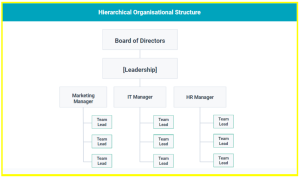
Source: Hubspot
The Hierarchical Structure is the most common type. It has a well-known pyramid shaped structure and a top-down approach to management. The main features are:
- Clear Chain of Command
- Top-down approach
- Extreme Centralisation
- Resistant to Change
The main benefit of a Hierarchical Structure is that processes are streamlined. The clear Chain of Command and Span of Control align employees with the direction the company is taking. It creates a clear career path and reduces internal conflicts. Employees can focus on their tasks.
The main disadvantage of the Hierarchical Structure is the lack of Decentralisation: employees cannot give their inputs regarding the direction of the company: the risk of alienation is real. Poor leadership will not be opposed and can bring the entire organisation down.
2. Functional Structure
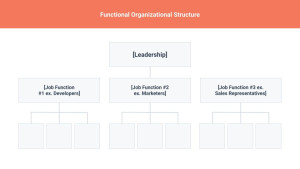
Source: Hubspot
The Functional Structure is one of the most common organisational structures. The main features are:
- It is based on Work Specialisation.
- Departments are created based on the competencies of the employees (e.g., marketing, sales, HR).
- For every department there is a manager that supervises all activities of the department.
- It implements a top-down decision making process.
The main benefits of the Functional Structures consist of a high degree of specialisation and efficiency for the employees of every department. Each department can focus on clear and specific goals, and employees can optimise their skillset to maximise performance according to their roles and responsibilities. The Functional Structure is also highly scalable.
The main disadvantage of the Functional Structure is that it creates a strong barrier between departments. Each department has its own silo that does not communicate with the others. Plus, the top-down decision-making process creates an environment where change can be hard to come by.
3. Divisional Structure
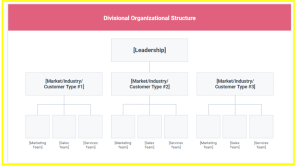
Source: Hubspot
The Divisional Structure is one of the most versatile organisational structures. It can be Market-based, Industry-based, Product-based or Area-based . The main features are:
- Autonomous Teams: each department has its own teams for marketing, sales, HR, etc.
- Financial Control: each division has complete control of their budget, resources and strategy.
- This structure is the most common for large enterprises and multinational companies that operate in multiple countries, industries and/or have multiple products.
The main benefits of the Divisional Structure are that it allows large enterprises to understand specific markets, industries or products with in-depth expertise and to have faster responses to changes, opportunities and threats.
It also allows organisations to mitigate the risks: if one division is under-performing the negative repercussions will not extend to other divisions.
The main disadvantages of the Divisional Structure are the redundancies and lack of brand cohesion because each division is autonomous and highly decentralised. This creates an environment where company policies and documentation are not shared among divisions.
4. Process-based Structure
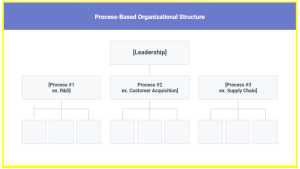
Source: Hubspot
The Process-Based Structure is designed around specific processes. Each process has to be completed before moving on to the next one. The main features are:
- High level of Departmentalisation
- Clear Chain of Command and Span of Control
The main benefit of a Process-based Structure is that it is easily adaptable to changes in the industry. Each department is highly specialised and autonomous. Thus, it can easily adapt its activities to any change.
The organisation can focus its resources on one specific process (e.g., Research & Development) all together and aim to complete it efficiently.
The main disadvantages of the Process-based Structure are that departments are prone to become silos that do not communicate, using different practices that are not integrated and thus losing valuable information without maximising profits.
5. Matrix Structure
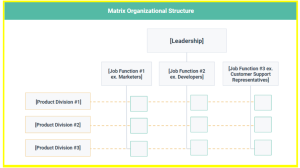
Source: Hubspot
The Matrix Structure does not follow the traditional hierarchical structure. Instead, each employee reports to multiple (at least 2) supervisors: one reporting line is based on function (e.g, Marketing, Sales, HR team) and the other is product-based . The main features are:
- Two Chain of Commands instead of one
- More complex Span of Control than other structures
- Shared resources and information
The main benefit of a Matrix Structure is that it offers more flexibility within the company and that it optimises resources by sharing them among departments and projects according to their needs. Communication is also strengthened due to the overlapping Span of Control.
The main disadvantages of the Matrix Structure are its complexity and the necessary overlapping Span of Control. If two supervisors have different project visions, then decision-making and results might be compromised.
6. Circular-based Structure
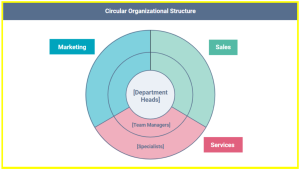
Source: Hubspot
The Circular-based Structure offers a different perspective on the usual representation of an organisational structure. The department heads are at the centre, capable of influencing everyone who surrounds them, i.e., team managers and specialists that belong to different departments. The main features are:
- Chain of Command and Span of Control are harder to understand for new employees
- Centralised towards the Department heads
- Shared Communication and Information
- Ideal for smaller organisations
The main benefit of a Circular-based Structure is that communication between departments is encouraged, since everyone is influenced by the department head. A clear and efficient communication system has to be put in place to give constant updates to the company, otherwise the junior employees don’t share the vision and direction given by the department heads.
The main disadvantages of the Circular-based Structure are that the Chain of Command and the Span of Control can be unclear to new hires. It can be hard to understand who is the specific supervisor for each resource. It could be hard to apply this structure to large organisations.
7. Team-based Structure
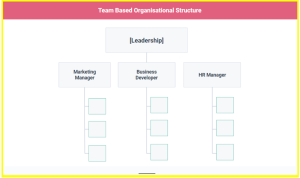
Source: Hubspot
The Team-based Structure allows employees to influence the business decision with their inputs and personal initiative. It is different from a Functional or Divisional Structure because teams have more autonomy and ownership of the project/product they are working on. The main features are:
- Focus on Departmentalisation
- Focus on autonomy and ownership of each employee
- Less focus on a rigid Chain of Command
- Bottom-Up approach to management
The main benefit of a Team-based Structure is that each Team has the ownership of their projects. This allows team members to make decisions autonomously in order to achieve the best results. This structure is ideal for companies that value innovation and quick response to market changes. Information and skills are shared among team members.
The main disadvantages of the Team-based Structures are the unclear Chain of Command as teams adopt an Agile working method without authorisation. Each team member has to adopt a flexible mindset, knowing that they will have to learn multiple skills, and a sense of responsibility towards their colleagues: the team has to fulfil the requirements of the project. If someone is not doing their part, the others will have to compensate.
8. Network Structure
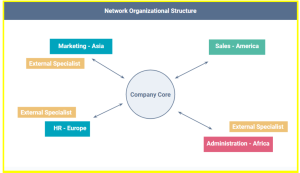
Source: Hubspot
The Network Structure is ideal for companies that operate in multiple locations with dispersed leadership, having outsourced roles, and/or sharing resources with other companies. The main features are:
- Communication between internal and external resources can be difficult
- Complex Chain of Command and Span of Control due to the involvement of external resources
- High Departmentalisation and limited shared information
- Possibility to achieve economies of scale
The main benefit of a Network Structure is that internal employees can become highly specialised in their activities and that external specialists can be outsourced to reach better results. For companies that share resources with other companies, economies of scale can be achieved to reduce costs and maximise profits.
The main disadvantages of the Network Structure are lack of communication between internal and external resources</b > and lack of cohesion and brand identity. It is hard to feel like one team when you have never met most of your colleagues. It can be difficult for new resources to understand who is the person in charge of a task, and how to efficiently reach them.
9. Flat Organisational Structure
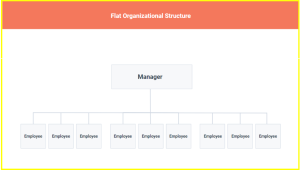
Source: Hubspot
The Flat Organisation Structure, also referred to as “flatarchy” or “horizontal structure” is typically used by start-ups and small businesses. All employees are within reach of the head of the organisation. The main features are:
- Faster decision making
- Typically used by start-ups and small businesses
- Decentralised
The main benefit of a Flat Organisation Structure is that a strong Decentralisation allows all employees to give their input, creating a stronger sense of belonging. Communication is open and information is shared across the organisation.
The main disadvantage of the Flat Organisation Structure is that it is not scalable and that its success revolves around personal initiative and skills employees. They have to take ownership of their activities and find solutions to all possible problems.
Conclusion
Knowing the possibilities of organisational structure is important for leaders to be able to define the best structure for their organisation. The conducted analysis on the benefits and disadvantages of 9 organisational structures can help leaders evaluate how each structure could fit their company, whilst keeping in mind how its employees can perform better.
If you are interested in learning more about best practices that can be implemented at an organisational level, read our blogs “Organisational Agility in SAFe” and “How Effective Organisational Change Management Can Impact Your Employees“.
QRP supports organisations to achieve professional excellence in Project Management, IT Governance & Service Management, Agile, Change Management, Programme, Portfolio and PMO Management through worldwide recognised accreditations. Check our full offer on our website or contact us.

















